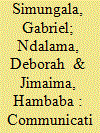| Srl | Item |
| 1 |
ID:
185142


|
|
|
|
|
| Summary/Abstract |
We draw from the meaning-making practices on the margins, the communicative repertoires of the multilingual and multicultural students at two Southern African universities: the University of Zambia in Lusaka, Zambia; and the University of Malawi in Zomba, Malawi. As our locus, we are interested in the unique linguistic/semiotic coinages which constitute the students’ linguistic repertoires as multilingual innovations amenable to placemaking. In an attempt to do this, we purposefully unearth lexical innovations which we analyse within the broader framework of translanguaging. Thus, we show the emergence of (new) lexical items through the (re-)invention and disinvention of communicative resources, and the deployment of material artefacts of place as a basis for the creativity and innovation through repurposing of lexical items for new uses. Thus, we privilege students as active manipulators of their communicative practices by showing the semiotic/linguistic creativity and innovation inherent in their repertoires.
|
|
|
|
|
|
|
|
|
|
|
|
|
|
|
|
| 2 |
ID:
182469


|
|
|
|
|
| Summary/Abstract |
In this article, we examine the multilingual realities of language contact at the University of Zambia. Using an ethnographic research design, we observe the dynamics of the students’ language practices both in the physical and on the online landscape. As our locus, we use a physical conversation and Facebook narratives in which students drew on English and Bemba to illustrate instances of blending and mixing as multilingual practices arising from translanguaging. We show that the mixing of words and the blending of morphemes from the two different languages gives evidence of how students (re)create, (re)produce, and (re)shape their meaning-making instances.
|
|
|
|
|
|
|
|
|
|
|
|
|
|
|
|